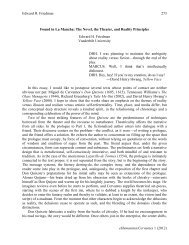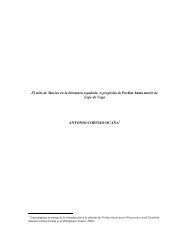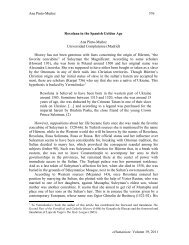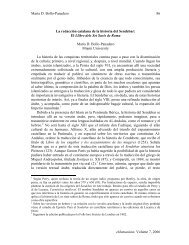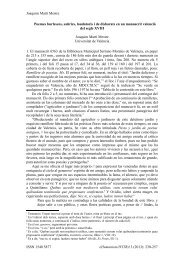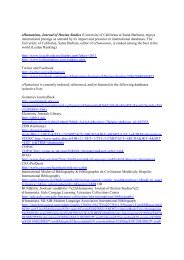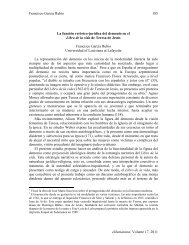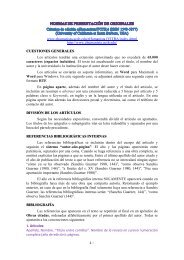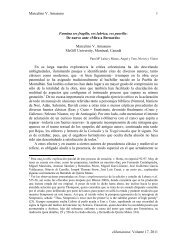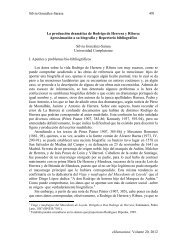Gregory Peter Andrachuk eHumanista: Volume 17, 2011 540 Alonso ...
Gregory Peter Andrachuk eHumanista: Volume 17, 2011 540 Alonso ...
Gregory Peter Andrachuk eHumanista: Volume 17, 2011 540 Alonso ...
You also want an ePaper? Increase the reach of your titles
YUMPU automatically turns print PDFs into web optimized ePapers that Google loves.
<strong>Gregory</strong> <strong>Peter</strong> <strong>Andrachuk</strong><br />
un cuerpo de mil infantes y algunos caballos (sic) que hiciese la guerra a los<br />
comuneros” (302). 29<br />
One of the most important sources regarding <strong>Alonso</strong> de Cardona as Almirante de<br />
Aragón is the article by the Marqués de Laurencín on the chronology of the Admirals<br />
–and here we begin to make progress. Under the section on <strong>Alonso</strong> de Cardona we<br />
learn that he was “hijo de D. Juan Folch de Cardona y Navarra, II Señor de Guadalest,<br />
Mayordomo Mayor del Príncipe Don Carlos de Viana su primo, …y de Doña María de<br />
Fajardo y Quesada, hermana del Conde de Cartagena D. Pedro (de Fajardo),<br />
Adelantado Mayor de Murcia” (354).<br />
The fact that <strong>Alonso</strong> de Cardona, Almirante de Aragón, was at that time counted in<br />
the highest ranks of nobility is not only a matter of family ties; it is confirmed by his<br />
active role in society. Enrique García Hernán writes of Juan de Borja, Duque de<br />
Gandía, preparing the way for his young son Francisco de Borja as he begins his<br />
training as courtier in 1521: “Juan de Borja escribió al gran canciller Gattinaria, al<br />
tesorero general, al Almirante de Aragón don <strong>Alonso</strong> de Cardona, al Duque de<br />
Alba...Así pues, a pesar de su corta edad, su padre le había preparado muy bien el<br />
terreno para ser perfectamente aceptado y reconocido por los de su misma nobleza”<br />
(191, emphasis mine). The connection between <strong>Alonso</strong> de Cardona and the Borjas is<br />
not only one of rank. In 1502 Don Juan de Cardona and his son <strong>Alonso</strong> sold to the<br />
Duquesa de Gandía, María Enríquez de Borja, a tract of land known as the Real de<br />
Gandía as a means of relieving debts incurred. 30 This land, occupied by communities<br />
of mudéjares, had been given to Hugo Folch de Cardona, son of Juan Ramón Folch de<br />
Cardona and Juana de Aragón in 1407 by his grandfather Alfonso de Aragón, along<br />
with other holdings including the villages of Confrides and Ondara. Hugo also<br />
inherited other tracts of land including, from his mother, the Vall de Guadalest. Of<br />
29 An account of the complicated history of the germanías can be found in Antonio Carrasco Rodríguez;<br />
he also mentions this meeting in Gandía and the importance of <strong>Alonso</strong> de Cardona: “una reunión en<br />
Gandía con los nobles y caballeros del reino que habían de luchar contra los agermanados...y para<br />
facultar la tarea, D. Diego Hurtado de Mendoza mandó al Almirante de Aragón D. <strong>Alonso</strong> de Cardona<br />
para que, ejerciendo toda su influencia (obtuviera) del Marqués de los Vélez ayuda para la defensa de la<br />
citada fortaleza” (223). Further evidence of the involvement of <strong>Alonso</strong> de Cardona in these matters is<br />
found in Luis de Qúas whose near-contemporary account lists the major participants in the king’s<br />
forces, including the Conde de Oliva, Francisco Fenollet and “don Alfonso (sic), Almirante de Aragón,<br />
éste con su bandera, cajas de guerra y caballo”(89). There is further mention in Miguel García (152)<br />
which puts <strong>Alonso</strong> de Cardona in the company of the Conde de Concentayna: “mientras que el conde de<br />
Concentayna y don <strong>Alonso</strong> de Cardona fueron hacia Segorbe...” On the occasion of the death of the<br />
Condesa de Concentayna <strong>Alonso</strong> de Cardona wrote “Ya mi alma entristecida”, a glosa on a poem by<br />
Geronì Vich, which appears in the Cancionero General. There can be no doubt that the poet of the<br />
Cancionero General and the Almirante de Aragón are one and the same person.<br />
30 José Luis Pastor Zapata explains the nature of the debts, called “censales”: “el recurso constante y<br />
progresivo de la nobleza local a empréstitos…respaldados generalmente por las comunidades sobre las<br />
que (la nobleza) ejerce el señorío;….algunos señoríos y sus titulares se vieron cargados…de deudas<br />
generadas por el capital y los intereses de los censales en un proceso que condujo…a la venta o<br />
transferencia de la propiedad feudal” (738).<br />
553<br />
<strong>eHumanista</strong>: <strong>Volume</strong> <strong>17</strong>, <strong>2011</strong>



